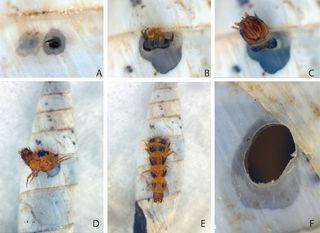Squatter Beetles Eat Snails and Steal Shells

The awkward stage of adolescence drives some insects to murderous home invasion.
When the time comes to shed their skin, certain beetle larvae in Greece scout out a sleeping snail, break into its shell, eat the victim alive and then squat in its home for days.
But the snail targets aren't completely defenseless; on the contrary, they may be locked in an evolutionary arms race with the juvenile beetles, trying to outwit their intruders with break-in-proof shells and other security strategies, a new study finds. [Beastly Feasts: Amazing Photos of Animals and Their Prey]
When beetles attack
To endure the Mediterranean heat during summer, Albinaria snails go into estivation, a dormant state similar to hibernation. They fuse themselves to limestone rocks using dried mucus and a clausilium, a spoon-like door near the shell's opening.
While the snails are in this vulnerable deep sleep, larvae of the Drilus beetle genus launch their attacks. The insects spend a few hours boring into the shell using their jaws and saliva, which may be acidic enough to dissolve the calcium carbonate of the shell. At that point, there's little hope for the snail.
"You never find a borehole that has been repaired afterwards," said study researcher Menno Schilthuizen, a biologist at the Naturalis Biodiversity Center in the Dutch city of Leiden. "Once the larvae have managed to get through the shell, there's no escape anymore."
Sign up for the Live Science daily newsletter now
Get the world’s most fascinating discoveries delivered straight to your inbox.
While studying this behavior, Schilthuizen and his colleagues discovered about 10 Drilus new species in Crete and mainland Greece that scientists had not yet described. The female beetles can't fly, which has led to a patchwork of different species stranded in relatively small areas. The same is true for the slow-moving snails, the researchers said. Both predator and prey may have evolved locally specialized features and behaviors in response to each other's advances in attack modes and defenses.
For example, many estivating snails group together in tight clusters, sometimes hundreds of individuals strong, which protects the gastropods from beetle invasions. Some Albinaria snails also have a more tightly fitted clausilium, but the beetles that prey on these snails seem to have figured out exactly where to bore their holes so that they don't get trapped behind the hatch.
"It's a lot more complex than we thought because there are lots of different beetle species, which we didn't know because they all look the same," Schilthuizen told Live Science.
Secretive squatting
The study, described today (June 25) in the journal PLOS ONE, really started 20 years ago, when Schilthuizen was investigating how different Albinaria species form in Crete for his doctoral thesis. In the field, Schilthuizen kept finding empty shells with tiny, distinct holes, and he figured that some predator must be devouring the snails from the inside.
"We never fully understood what was eating them until I started finding shells with a borehole and a dead, dried-up beetle larva half-outside, which clearly had died as it was coming out of that hole," Schilthuizen said.
He wasn't the first to document the phenomenon; Schilthuizen said he later found a German scientific paper from 1851 describing the same snail vs. larvae struggle.
"It proved the rule that you can never really discover anything new because you'll always find it in some old German publication," Schilthuizen said.
Still, no one ever witnessed a beetle execute one of its break-ins, because the larvae wait until darkness falls to strike.
To study the mysterious attacks, Schilthuizen and colleagues collected live samples of the beetles and snails. In the lab, the researchers found that the beetles molt up to eight times before reaching adulthood, and each time the insects shed their exoskeletons, they attacked a new snail, then lived inside the shell for a few weeks.
"When they molt, they're extra vulnerable, because the new skin needs to harden before they're safe from drying out," Schilthuizen said. "The shell also gives them protection while they are recovering from the molting, so they basically use the shell the same way the previous occupant did."
The team's video footage of the attacks also shows that when the hiding juvenile insects are ready to go back into the world, they often create a second hole to escape, because the shell is too narrow for the larvae to make a U-turn. Eventually, they move on to look for another victim.
Follow Megan Gannon on Twitter and Google+. Follow us @livescience, Facebook& Google+. Original article on Live Science.

Most Popular

